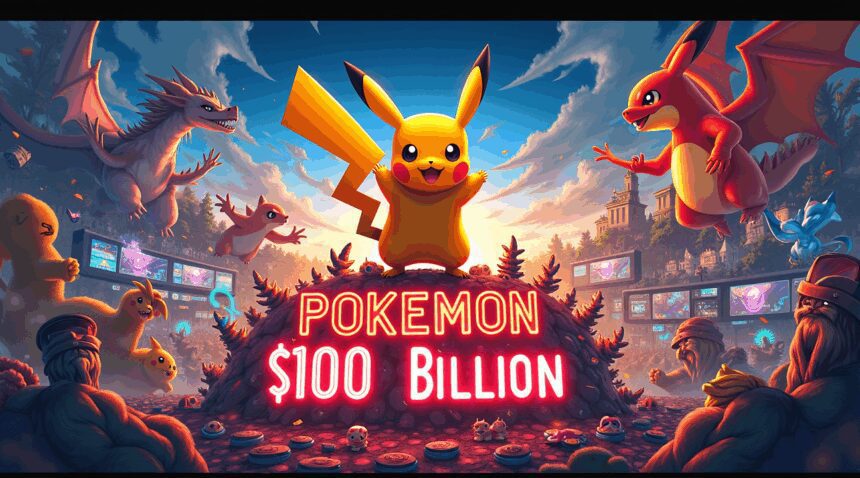Pokemon stands as the world’s most valuable media franchise at $100 billion through consistent evolution across multiple platforms while keeping its core appeal intact.
Recent releases like Pokemon Scarlet and Violet selling over 26.79 million units demonstrate the franchise’s power to captivate both nostalgic fans and new generations. This sustained relevance comes from strategic expansion beyond traditional gaming into mobile experiences, trading cards producing over 10 billion units annually, and innovative features that engage players across different life stages and gaming preferences.
Key Takeaways
- Pokemon has achieved over 489 million video game sales worldwide, making it the fourth best-selling video game franchise in history with consistent growth across two decades.
- Recent releases continue breaking records, with Scarlet and Violet becoming the second-best selling Pokemon games ever at 26.79 million units, surpassing even Sword and Shield’s success.
- The Trading Card Game maintains massive production scales, with over 10.2 billion cards produced in fiscal year 2024/2025, contributing to a lifetime total exceeding 75 billion cards.
- Platform diversification through Nintendo Switch (hosting 12+ Pokemon titles) and mobile games like Pokemon GO has made the franchise accessible to players across all age groups and gaming experience levels.
- Strategic innovation balanced with nostalgic content creates multi-generational appeal, from competitive tournaments and community events to remakes and experimental gameplay formats that respect tradition while embracing new possibilities.
The World’s Most Valuable Gaming Empire: Pokemon’s $100 Billion Legacy
Pokemon stands as the most valuable media franchise on the planet, commanding an extraordinary lifetime franchise value of approximately $100 billion. This astronomical figure reflects decades of consistent innovation and strategic brand expansion that has kept the franchise fresh and profitable across multiple generations of fans.
The mainline video game series alone has achieved remarkable commercial success, selling over 489 million units worldwide as of March 2025. This impressive milestone positions Pokemon as the fourth best-selling video game franchise in history, trailing only legendary series like Mario and Tetris. Such sustained performance demonstrates the franchise’s exceptional ability to capture and maintain audience interest across different gaming platforms and technological advances.
Consistent Growth Trajectory Across Two Decades
The franchise’s sales progression tells a compelling story of steady expansion and market penetration:
- 100 million units sold by 2005, establishing Pokemon as a major gaming force
- 380 million units reached by March 2021, showing remarkable pandemic-era growth
- 440 million units achieved by June 2022, maintaining momentum post-pandemic
- 480 million units recorded by May 2023, demonstrating continued appeal
- 489 million units confirmed by March 2025, solidifying its position among gaming giants
These figures reveal Pokemon’s unique capacity to attract new players while retaining existing fans through innovative releases and strategic franchise management. The consistent year-over-year growth indicates that Pokemon hasn’t simply relied on nostalgia but has actively evolved to meet changing consumer preferences and gaming trends.
Pokemon’s success extends far beyond traditional gaming boundaries, encompassing trading cards, animated series, movies, merchandise, and mobile applications. This diversified approach has created multiple revenue streams that reinforce each other, building a self-sustaining ecosystem of entertainment products. The franchise’s ability to generate substantial profits across various media formats explains its unmatched $100 billion valuation.
The company’s strategic approach to competitive play and continuous content updates has kept the gaming community engaged long after initial purchases. Regular tournaments, seasonal events, and downloadable content ensure that Pokemon games maintain active player bases well beyond their launch windows, contributing to sustained franchise value and brand loyalty.
Record-Breaking Recent Releases Prove Pokemon’s Ongoing Dominance
Pokemon Scarlet and Violet achieved over 26.79 million units as of March 2025, cementing their position as the franchise’s second-best selling game ever after just over two years. This remarkable milestone surpassed even the highly successful Sword and Shield, which sold approximately 26.7 million units. Only the original Red/Green/Blue games maintain their throne at number one with 31.38 million units – a testament to both the franchise’s enduring legacy and its ability to capture new generations of trainers.
The launch performance of Scarlet and Violet shattered industry expectations. During its first weekend alone, these titles sold over 10 million copies worldwide, with 4 million units moving in Japan specifically. Such explosive opening numbers demonstrate the franchise’s incredible staying power and the passionate dedication of its global fanbase.
Generation 9 Continues a Pattern of Success
Recent Pokemon releases consistently achieve best-seller status on Nintendo’s biggest console, the Switch. This pattern extends beyond just the mainline entries to encompass the entire portfolio of contemporary Pokemon games.
- Pokemon Brilliant Diamond and Shining Pearl reached over 15 million units, proving that even remakes can captivate modern audiences.
- Pokemon Legends: Arceus achieved 14.8 million units, showing that experimental gameplay approaches can thrive alongside traditional formulas.
These sales figures paint a clear picture of a franchise that hasn’t just maintained relevance – it’s actively growing its market share. Each release builds upon the success of its predecessors while introducing fresh mechanics and storylines that keep players engaged. Pokemon Scarlet and Violet’s staying power exemplifies this strategy perfectly, combining familiar core mechanics with innovative open-world exploration.
Strategic Platform Positioning Drives Market Dominance
Nintendo Switch’s massive install base provides the perfect platform for Pokemon’s continued success. The console’s versatility allows players to enjoy Pokemon adventures both at home and on the go, removing barriers that might otherwise limit engagement. This accessibility factor contributes significantly to the impressive sales numbers across all recent releases.
The franchise’s ability to adapt to changing gaming preferences while maintaining its core identity explains these record-breaking performances. Generation 9 competitive play continues to evolve, keeping experienced players invested while new mechanics welcome newcomers. Each title offers multiple layers of engagement, from casual story completion to serious competitive battling.
Looking at the broader market context, these sales figures become even more impressive. Pokemon games consistently outperform many AAA titles from major publishers, demonstrating the franchise’s unique position in gaming culture. The continued success of both mainline entries and experimental titles like Legends: Arceus shows that The Pokemon Company understands how to balance innovation with tradition.
Generation 9’s competitive scene has maintained momentum well beyond the initial launch window, with players discovering new strategies and team compositions months after release. This sustained engagement translates directly into continued sales as word-of-mouth recommendations drive additional purchases.
The numbers speak for themselves: Pokemon isn’t just staying relevant – it’s defining what relevance looks like in modern gaming. With Scarlet and Violet approaching the sales figures of legendary entries like Red and Blue, the franchise proves that innovation and nostalgia can coexist successfully. Each release builds a foundation for future success while honoring the elements that made Pokemon a cultural phenomenon in the first place.
https://www.youtube.com/watch?v=6OvWQvCjGmM
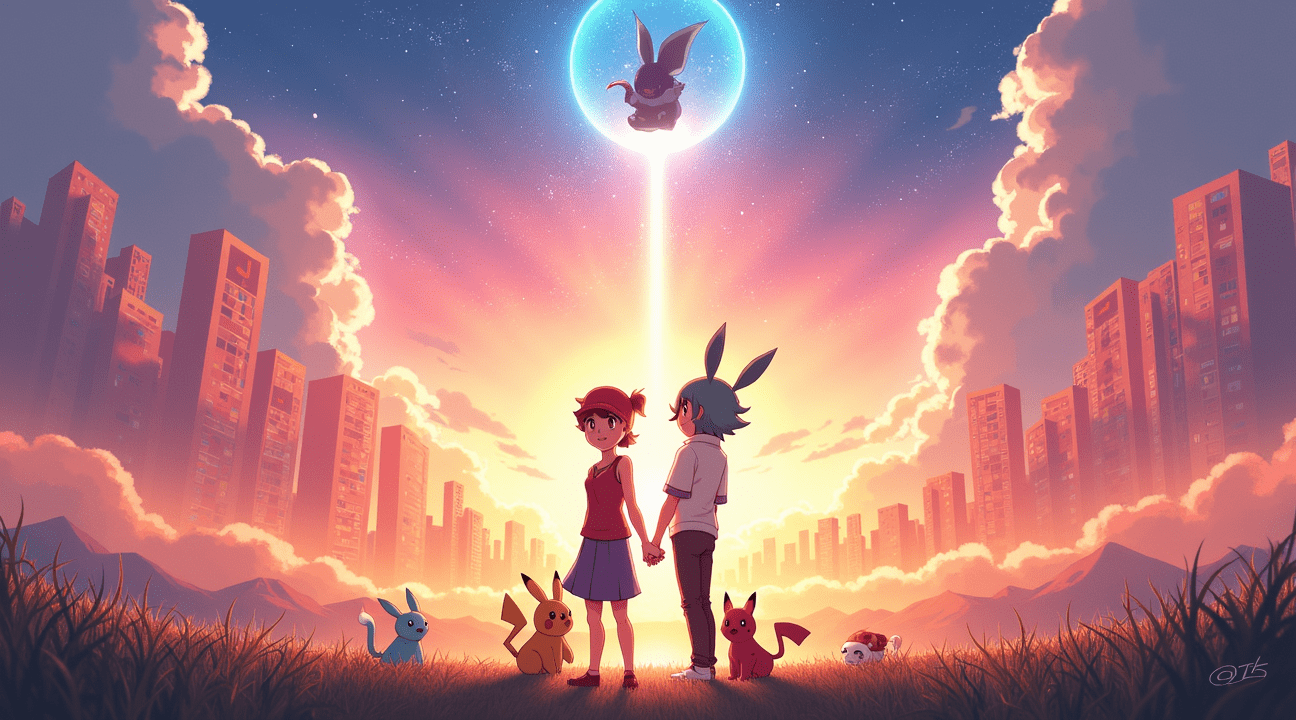
Trading Card Game Produces Over 10 Billion Cards Annually
The Pokemon Trading Card Game continues to showcase remarkable production numbers that reflect its sustained popularity across global markets. I find the scale of card production absolutely staggering when examining the latest fiscal data.
Massive Production Numbers Drive Industry Leadership
Pokemon produced over 10.2 billion cards during fiscal year 2024/2025, contributing to a cumulative lifetime production that has now surpassed 75 billion cards. While this represents a decrease from the previous year’s peak of 11.9 billion cards in 2023/2024, the numbers still demonstrate extraordinary demand for physical Pokemon products in an increasingly digital entertainment landscape.
The production trajectory over recent years tells a compelling story of growth. Lifetime card production experienced explosive expansion from 34.1 billion cards in 2020/2021 to 75 billion in 2024/2025. This represents a growth rate exceeding 120% in just four years, highlighting how Pokemon maintains relevance across multiple product categories simultaneously.
Strategic Market Positioning Through Sustained Demand
The scale becomes even more impressive when considering that 13.6% of all Pokemon cards ever produced were manufactured in just the last fiscal year. This statistic reveals that despite decades of card production, current demand remains incredibly strong. The Pokemon Company has successfully maintained collector interest while attracting new players to the trading card game format.
Production numbers of this magnitude require sophisticated supply chain management and global distribution networks. The ability to consistently produce billions of cards annually while maintaining quality standards demonstrates operational excellence that few entertainment companies can match. These figures also indicate that physical collectibles remain highly valued by consumers, even as digital gaming experiences continue expanding.
Card production at this scale directly supports competitive play infrastructure and collector communities worldwide. The steady supply ensures tournament organizers can access necessary materials while collectors find diverse product lines to pursue. Recent data suggests that both casual collectors and serious competitive players drive demand, creating a multi-tiered market that supports sustained production levels.
Manufacturing costs and logistics for producing over 10 billion cards annually require significant investment in printing facilities, materials sourcing, and quality control systems. The Pokemon Company’s commitment to maintaining these production levels reflects confidence in long-term market demand and the trading card game’s position within the broader Pokemon ecosystem.
Market analysis indicates that trading card sales complement rather than compete with video game releases. Competitive Pokemon formats benefit from consistent card availability, while new set releases often align with video game launches to maximize cross-promotional opportunities.
The slight decrease from 2023/2024 to 2024/2025 production levels likely reflects market stabilization after the explosive growth period during 2020–2022. Industry observers note that while pandemic-era collecting reached unprecedented heights, current production levels suggest a mature market with stable, predictable demand patterns.
International markets contribute significantly to these production figures, with localized versions of cards requiring additional manufacturing considerations. The Pokemon Trading Card Game maintains active player bases across Asia, North America, and Europe, necessitating region-specific production runs and distribution strategies.
These production statistics position Pokemon as the dominant force in trading card manufacturing globally. Few entertainment franchises can sustain annual production exceeding 10 billion units while maintaining collector enthusiasm and competitive integrity. The numbers demonstrate that physical gaming products retain significant appeal despite digital entertainment’s continued expansion.
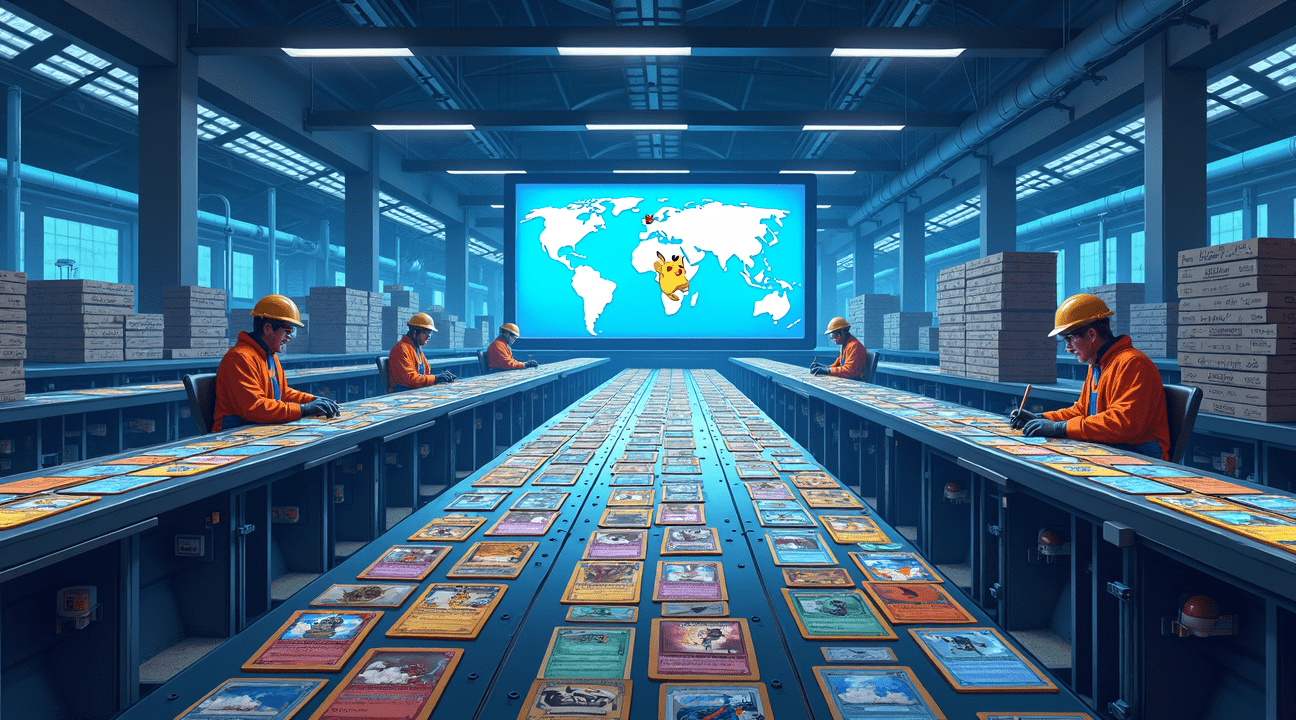
Mobile Gaming and Platform Expansion Keep Pokemon Accessible
Pokemon GO completely transformed how players experience the franchise when it launched in 2016, bringing Pokemon into the real world through augmented reality technology. This mobile game became one of the top-grossing mobile apps worldwide, proving that Pokemon’s appeal extends far beyond traditional handheld consoles. The AR format allows players to catch Pokemon in their neighborhoods, participate in raids with friends, and experience the thrill of discovery in familiar locations.
The success of Pokemon GO demonstrated the franchise’s ability to adapt to new technologies while maintaining its core appeal. Players who hadn’t touched a Pokemon game in years found themselves drawn back into the experience through their smartphones. The mobile platform removed barriers that traditional gaming systems created, making Pokemon accessible to anyone with a phone.
Nintendo Switch Becomes Pokemon’s Primary Console Hub
Nintendo’s Switch platform has become the definitive home for Pokemon games, hosting at least 12 distinct titles as of 2024. This impressive library spans multiple categories to satisfy different player preferences:
- New generation titles like Scarlet and Violet that push the series forward
- Faithful remakes such as Brilliant Diamond and Shining Pearl that honor classic experiences
- Entry-level games like Let’s Go, Pikachu and Eevee designed for newcomers
- Special raid experiences and downloadable content expansions
- Spin-off titles that explore different gameplay mechanics
The Switch’s hybrid nature perfectly complements Pokemon’s portable DNA while adding the option for big-screen gaming. Players can seamlessly transition from catching Pokemon during their commute to battling friends on the living room TV. This flexibility mirrors how Pokemon has always been about taking adventures anywhere.
Platform diversity ensures Pokemon reaches audiences across multiple gaming preferences and demographics. Casual mobile players might start with Pokemon GO, then graduate to Let’s Go titles on Switch, and eventually explore competitive Pokemon in the main series games. Each entry point offers a different perspective on what makes Pokemon special.
The franchise’s platform expansion strategy also includes innovative experiences like Pokemon Sleep, which gamifies rest and sleep patterns. These creative applications show how Pokemon can integrate into daily life beyond traditional gaming sessions. The company continues exploring new ways to make Pokemon relevant across different aspects of modern living.
Switch’s online capabilities have revolutionized how players connect with the Pokemon community. Trading, battling, and sharing experiences happen instantly across global networks. Generation 9 competitive play benefits tremendously from these enhanced online features, creating vibrant communities around both casual and serious gameplay.
The accessibility improvements across platforms can’t be overstated. Pokemon GO requires no gaming experience beyond basic smartphone use, while Switch titles offer multiple difficulty options and assistance features. Entry barriers have never been lower, allowing Pokemon to welcome new trainers regardless of their gaming background or technical skills.
Cross-platform integration adds another layer of accessibility and engagement. Pokemon GO connects with main series games through Pokemon HOME, creating a unified ecosystem where progress and collections carry forward. This interconnectedness encourages players to explore multiple Pokemon experiences rather than limiting themselves to single platforms.
Platform expansion has also enabled Pokemon to experiment with different art styles, gameplay mechanics, and storytelling approaches. Each platform’s unique capabilities influence how Pokemon games are designed and experienced. Mobile AR technology creates different emotional connections than traditional console gaming, while Switch’s capabilities allow for more complex adventures than previous handhelds could support.
The strategic use of multiple platforms keeps Pokemon fresh and relevant across different generations of players. Children discovering Pokemon through mobile games can grow with the franchise as they transition to more complex console experiences. Meanwhile, longtime fans can revisit classic games through remakes while exploring new innovations in recent releases.
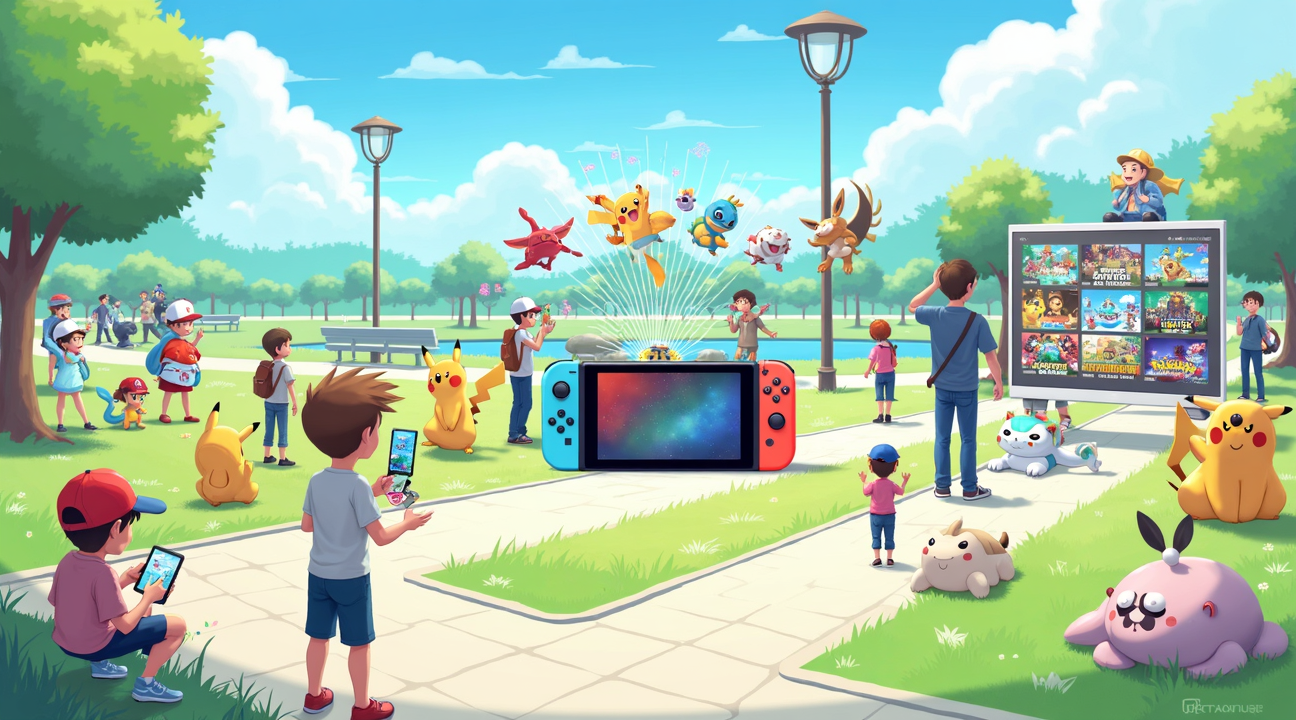
Multi-Generational Appeal Through Strategic Innovation and Nostalgia
Pokemon’s enduring success spans multiple generations because the franchise expertly balances honoring its legacy while embracing fresh innovations. The brand maintains its position as a cultural powerhouse by consistently delivering new experiences that capture both longtime fans and newcomers alike.
Strategic Release Patterns and Nostalgic Content
Pokemon sustains its momentum through carefully timed releases that arrive approximately every 2-3 years for mainline games. This schedule creates anticipation without oversaturating the market. Strategic remakes play a crucial role in this formula, allowing older fans to revisit beloved regions with modern graphics and gameplay mechanics while introducing classic storylines to younger players.
The franchise doesn’t simply recycle past content – it reimagines these experiences with contemporary features. Recent innovations like the open-world experimentation in Scarlet and Violet demonstrate how Pokemon pushes boundaries while respecting its core identity. These games broke traditional formula constraints, offering players unprecedented freedom to explore the Paldea region at their own pace.
Character evolution continues to drive emotional connections across age groups. Established Pokemon receive new forms, abilities, or regional variants that feel fresh yet familiar. Pikachu remains the franchise mascot, but newer Pokemon like Mimikyu or regional variants of classic creatures ensure the roster stays dynamic and relevant.
Community Engagement and Competitive Innovation
Active tournaments and community events serve as pillars supporting Pokemon’s multi-generational appeal. The competitive scene thrives through official championships, local tournaments, and online competitions that attract players from elementary school age through adulthood. Competitive play has evolved into a sophisticated ecosystem where strategy depth satisfies experienced players while remaining accessible to newcomers.
Community events extend beyond competitive battles. Pokemon GO’s community days, special raids, and regional events create shared experiences that bring players together physically and digitally. These gatherings strengthen the social bonds that keep fans engaged long-term, fostering relationships that transcend individual game releases.
Merchandising strategies reinforce Pokemon’s presence in daily life through products targeting different age demographics.
- Children collect plush toys and trading cards
- Adults purchase premium collectibles, apparel, and home goods
This diverse product ecosystem ensures Pokemon remains visible and relevant regardless of active gaming habits.
Multimedia expansion amplifies the brand’s reach through television series, movies, and mobile applications. Each platform introduces Pokemon to new audiences while providing existing fans additional ways to engage with their favorite characters and storylines. Pokemon Sleep exemplifies how the franchise explores unconventional gaming concepts that integrate with daily routines.
The franchise successfully targets both younger fans discovering Pokemon for the first time and returning adult audiences who grew up with the series. Storylines maintain enough complexity to engage mature players while preserving the wonder and accessibility that captivates children. Game mechanics layer simple surface gameplay over deeper strategic elements, allowing players to engage at their preferred level of complexity.
Pokemon’s innovation extends to exploring new game formats and platforms.
- Mobile games
- Virtual reality experiences
- Augmented reality applications like Pokemon GO
These ventures often introduce Pokemon to demographics who might never pick up a traditional handheld console.
Special distribution events and limited-time content create urgency and exclusivity that drives continued engagement. Legendary Pokemon distributions, shiny variants, and time-sensitive raids ensure players regularly return to their games even months after initial release. This strategy maintains active player bases while creating collectible moments that become cherished memories.
The franchise’s ability to evolve while maintaining its core identity explains its sustained relevance across multiple decades. Each generation of players discovers their own entry point into the Pokemon universe, whether through mainline games, spin-offs, or multimedia content, ultimately joining a community that spans age groups and cultural backgrounds.
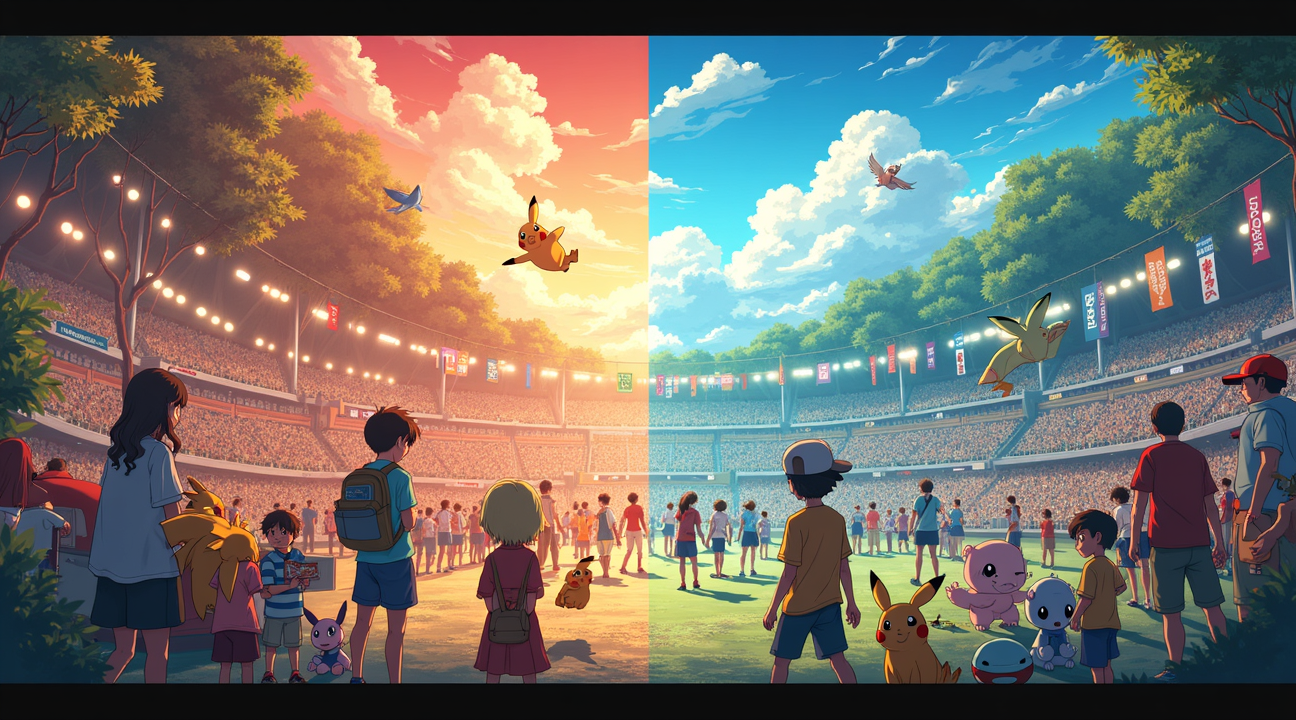
Sources:
Pokeguardian – Over 10 Billion Pokemon Cards Sold in Fiscal Year 2024-2025
Market.us – Video Games Market Report
Statista – Pokemon Unit Sales Worldwide
Install Base Forum – Pokémon Scarlet & Violet Has Become the 2nd Best Selling Pokémon Game of All Time After Just 2 Years and 1 Quarter on Sale
Nintendo – Financial Software Data
Wikipedia – Pokémon (Video Game Series)

